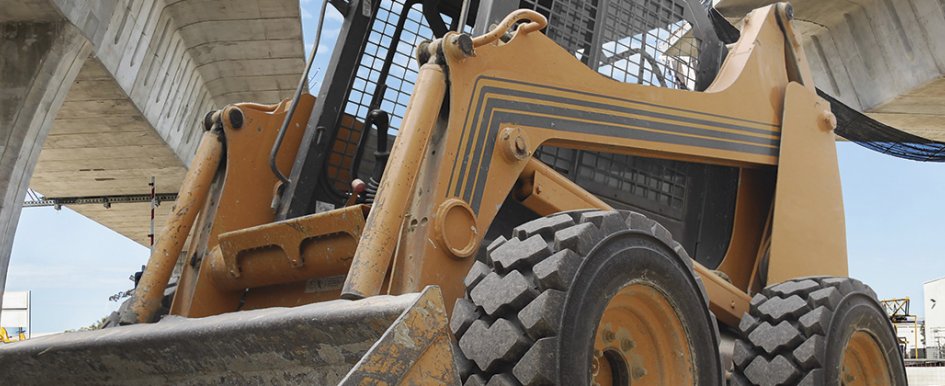
When the phone is ringing and the dirt is flying, your machines need to be rolling, and your equipment's tire performance can be critical to your success. That's why choosing tires that deliver the best return on investment can add profitability that goes beyond the price tag.
The dream tire would be cheap to buy, last the entire life of your machine, never wear down, grip like a claw in the mud, work three shifts a day without getting too hot and roll like it is on a cloud.
Of course, the world doesn't work like that, so buying a tire is like investing in any other piece of vital equipment—it's a business decision that balances your needs and your resources for the best return. The basic measure of a tire is its total cost of ownership (TCO), which incorporates a wide range of variables. Some of these variables may include:
- The purchase price of the tire
- The tire's length of service
- How well it keeps your machine moving on the jobsite
Price Point Decisions
The most fundamental number in the tire-buying equation is the price. You can find a tire at nearly any price point, so the more pressing question is whether it best fits your strategy to invest in a long-lasting tire or aim for a smaller up-front investment instead. At the heart of this decision are the following questions:
- How long do you plan to own the machine itself?
- Does your current cash flow position allow you to invest in a set of tires for the long haul, or is it better for your company to put up less up front and buy tires more often?
Billy and Jimmy Plante of Charles Plante and Sons Excavation and Paving in Springvale, Maine, use different strategies for different types of equipment. The brothers like to keep their excavator fleet less than 2 years old, so they operate excavators on the tires that come mounted as original equipment and end up trading in the machines before they wear out the rubber.
However, they keep skid steers for 3 years or more, which means they plan to purchase about three sets of tires for each machine. "They really take a beating," said Billy Plante.
The Plante brothers' tire dealers—Doug and Jeff Therrien of Central Tire in Sanford, Maine—advise local construction business owners who hold onto their loaders and skid steers for the long haul towards tires with massive tread blocks that can handle thousands of hours on pavement or rock, despite the higher purchase cost. Such tires are also better suited to handling Maine's ice winters. For the Plantes, a tire with less rubber and less upfront cost delivers both the performance and the value they need for machines they won't own forever.
"The question [our] customers always ask is, 'How long is this tire going to last?'" Therrien said.
Right Tire, Right Conditions
Choosing the right tire for its operating conditions goes a long way in maximizing service life and optimizing machine performance. Tractor-style lugs or bar treads are best used for soft surfaces and traction, while large, wear-resistant tread blocks are better suited for long life on pavement and over-the-road travel.
The smoother ride offered by big-block treads can have other subtle but important impacts on productivity. For example, minimizing whole-body vibration can reduce back pain and operator fatigue, helping keep your crew more productive for longer.
Even solid tires, previously notorious for their bumpy ride, can now be found with apertures to smooth out their overall performance. Equipment expected to take a severe grinding on pavement or operate at jobsites with severe puncture hazards may benefit from solid tires rather than pneumatic ones.
If your crew is small enough that specific operators are paired with particular machines, consider that aspect as you select tires for your equipment. Is your operator an aggressive driver, prone to turning at slow speeds or inclined to braking sharply, which can grind down treads? Try to find a tread with a compound or design that stands up well to his/her particular driving style.
Time Is Money
Opportunity cost—the money you could be making by doing something more productive—is at its highest when your operators are on the clock, standing next to idled equipment while a key machine awaits service. Time is money. Downtime is equal to lost money. Plante said their company's excavators are the hubs around which everything else revolves.
If an excavator were to go down, he figures it would cost him approximately $2,000 per day in lost revenue on that machine alone—plus the losses on a loader with an operator and a couple of trucks (at least $700 apiece per day) idled without rock or dirt to move. You can do similar math for any machine in your equipment fleet, from dozers and skid steers to excavators and backhoes.
Plante generally estimates projects by the job or the yard of material moved, not by the hour, so every idle hour cuts into his bottom line.
Of course, even the best tires have the potential to fail. Every once in a while, a rock will get crammed under a wheel rim or shear off a valve, Plante said, causing a surprise flat. But he said Central Tire gets his crews back in action in an hour or less—vital service that helps keep his business on the move.
As the Plantes have learned over the years, selecting the right tires based on the jobsite, machinery and how many hours you plan to put on your equipment can help keep your business as productive and profitable as possible.
